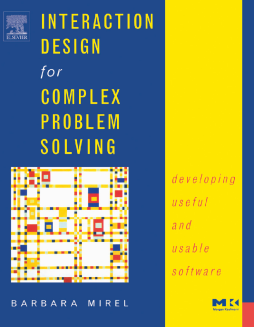
Additional Information
Book Details
Abstract
Software for complex problem solving can dazzle people with advanced features and alluring visuals, but when actually put to use it often disappoints and even frustrates users. This software rarely follows the user's own work methods, nor does it give people the degree of control and choice that they truly need.
This book presents a groundbreaking approach to interaction design for complex problem solving applications. The author uses her vast field experience to present a new way of looking at the whole process, and treats complex problem solving software and web applications as a distinct class with its own set of usefulness demands and design criteria. This approach highlights integrated interactions rather than discrete actions, clearly defines what makes problem solving complex, and explores strategies for analyzing, modeling, and designing for exploratory inquiries.
·In depth case studies ranging from IT troubleshooting to marketing analysis to risk assessments in healthcare show exactly where and what goes wrong in real world activities and how to improve them.
·Presents a system and framework for analyzing complex work and takes the mystery out of eliciting patterns of work and their meanings.
·Offers new perspectives for support and new design strategies for building the right models into programs so that they effectively address users' dynamic work.
·Allows designers to turn findings into useful designs for problems that require users to create new knowledge but with no one right answer and with many methods of reaching solutions.
If your team already has someone responsible for the HCI of your products, encourage them to read this book and discuss the resulting issues with you. In the context of a team it might also be helpful to make this book a team study effort so that you all better understand those extra constraints on the total product that are necessary to convert excellent software into excellent usable software.
--from a review by Francis Glassborow on accu.org
Barbara Mirel has spent years studying users for whom simple software solutions aren't sufficient. Interaction Design for Complex Problem Solving is the first book to tackle the thorny problem of developing software that is both usable and useful for users who have complex problems to solve. With clear explanations, detailed case studies, and thoughtful ideas about how to proceed, this is an excellent resource for designers, developers, and usability specialists.
--Janice (Ginny) Redish, Redish & Associates, Inc.
At last we have a text to help interaction designers, technical communicators, and programmers understand (rather than defeat) the complexities of users engaged in knowledge work in real-world contexts. Barbara Mirel's Interaction Design for Complex Problem Solving weaves theory and practice into a coherent, rich framework for thinking about, researching, and designing powerful and useful systems.
--Johndan Johnson-Eilola, Clarkson University
Barbara Mirel cracks open the problem of software usefulness with vigor and ambition. Her rich analysis of real-world problem-solving scenarios yields insight into previously neglected general and domain-specific aspects of complex problems. From these she generates much-needed advice for designing intelligently useful software.
"Mirel's models for examining complex problem solving are interesting, and the implications for her argument are clear...Thus, this text is a new argument toward that push and a reshaping of our outlook toward design, formalized research methods, usefulness, and usability in general, which makes this text a densely rich read worth several explorations." - Victoria Sharpe - Technical Communication
--T. R. Girill, University of California, Lawrence Livermore National Laboratory
"The book is well worth reading. It provides a broad-based critique of oversimplifying approaches that is hard to beat and a level of sophistication about complex problem solving that would be hard to match. I am positive that I will return to it and cite it frequently as I continue to work through similar issues in my work." - Clay Spinuzzi - University of Texas at Austin
